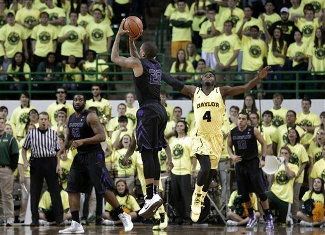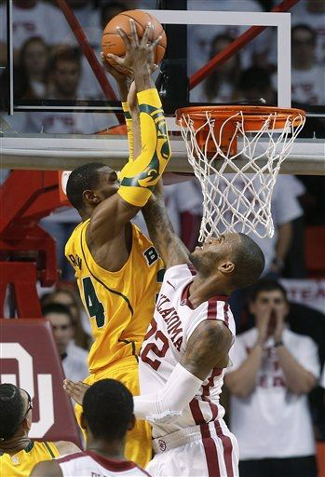Erwin Center | Austin, TX | Tip: 8 P.M. CT | TV: ESPN LRT Consecutive Game #250 When the Big 12 released its conference schedule last summer, Texas’ home finale against Baylor looked like it would be a very important Big Monday showdown. Although the consensus was that Kansas was once again the prohibitive favorite, both the Bears and Longhorns would likely be battling for seeding in both the Big 12 and NCAA tournaments. Baylor would probably be playing for the right to play its NCAA opening weekend games in Austin, while the Horns would be working towards their fifteenth consecutive NCAA appearance, and perhaps a favorable draw that would feed into the Arlington regional.
Pierre Jackson and Baylor are sweating on the bubble Instead, tonight’s game is huge for very different reasons. The Bears have lost four out of their last five and currently sit in the “First Four Out” of Joe Lunardi’s latest Bracket Math ($), with Kansas coming to town on Saturday. While a win over Texas does nothing to improve Baylor’s lot, a defeat at the hands of a Longhorn squad holding an RPI of 122 would be crippling. There’s also the distinct possibility that the Bears could finish the season below .500 in the Big 12, with only one of their league wins coming against a team projected to be in the NCAAs. Earlier this season, Lunardi also ran the numbers ($) on teams who made the NCAA field with a losing record in conference play. In the last 10 seasons, only nine squads earned at-large bids with losing records in their leagues. Six of those nine teams had non-conference strength of schedules that ranked in the top 50 nationally; Baylor’s is ranked 43rd. The numbers would seem to give the Bears some hope that they could survive losses in their last two games, especially with all of the horrible losses suffered by other bubble teams this weekend. Still, antiperspirant sales would skyrocket in Waco ahead of Selection Sunday if the Bears were to lose to both Texas and Kansas this week. That would give Baylor a 1-6 record in its last seven games, and an 8-10 mark in the conference. It’s safe to say that tonight’s game is a must-win for the reeling Bears. For Texas, the stakes are much lower. The Longhorns have no shot at an at-large bid to the NCAAs, and would need to win four games in four days at the Big 12 Championship in Kansas City to make the field. There are still post-season options in the form of the NIT and CBI, but as we explained in the TCU game preview two weeks ago, even the NIT looks like a long shot. Although the rule was removed that requires NIT teams to have a .500 record, no team with a losing mark has ever actually been invited to the tournament. Even with wins against Baylor and Texas Tech this week, the Horns would still have to win their opener in KC and then upset the No. 1 or No. 2 seed in the quarterfinals just to reach that .500 mark. The Longhorns could still be selected for the College Basketball Invitational with a losing record, but there’s no guarantee that Texas would even accept that bid. The CBI is a 16-team tournament that culminates with a best-of-three championship series, with all games at campus sites. In the five-year history of the event, six of the 80 participating teams played with a losing record, and all were from the Big East or Pac-12. As long as the Horns avoid losing their next three games, it’s hard to imagine the Gazelle Group not inviting Texas, which participates in many of its November tournaments. Still, it’s incredibly sobering to reflect upon how far expectations have fallen in just six short months. Meet the Bears For an in-depth look at the Baylor roster and the team’s tendencies, check out LRT’s game preview from the first meeting between these two teams. The first match-up In the first Big 12 game of the year, it was overworked freshman point guard Javan Felix who shouldered the load for Texas. With the Longhorns down nine at the half, Felix came out of the locker room firing and poured in 15 second-half points to carry the Horns into overtime at Baylor. In the extra period, Felix scored the first four points for Texas, which led by one with only 1:29 to go. The Bears responded with three free throws over the next half-minute, leaving the Horns with a two-point deficit, the ball, and 50 seconds to go. But, after leading the Texas upset bid all afternoon, it was Felix who missed an ugly turnaround jumper to tie the game with 30 seconds to go. After a few more Baylor free throws and some desperation attempts from Texas, the Bears escaped with a seven-point win in overtime. The biggest difference in the game was Baylor’s composure at the free-throw line. The Bears were more aggressive all afternoon, hustling for rebounds and loose balls, while the big men repeatedly got to the rim against the Texas frontcourt. All told, Baylor shot 45 free throws in the game, knocking down 80% of their attempts. In a game that had to go an extra five minutes to decide the winner, missing just a free throw or two during regulation could have resulted in a loss for Baylor. The Bears were led by a 25-point performance from Pierre Jackson (No. 55). He scored 11 of those points in overtime, including 9-of-11 shooting at the charity stripe in the extra period. Baylor’s twin towers, Cory Jefferson (No. 34) and Isaiah Austin (No. 21), combined for 33 points and 22 rebounds against the overmatched Texas forwards. Since then…
Rodney McGruder shocked Baylor at the buzzer Thanks to a quirk in the schedule, Baylor and Texas have gone more than eight weeks between their two meetings this season. The Bears are now sitting in sixth place in the Big 12, just one game behind Iowa State with two games to go. Unfortunately, seven of their eight wins have come against the four teams below them in the standings, with their home win against Oklahoma State providing the only victory against an upper-division Big 12 team. The struggles have intensified in recent weeks. Baylor has lost four out of five, including a heartbreaking defeat against Kansas State on Saturday. The Bears never let the Wildcats get ahead by more than six in the second half, and ended up with the ball and a second left in a tie game. A full-court heave from rarely-used Jacob Neubert went out of bounds untouched, giving K-State the ball under its own basket. The Bears lost Rodney McGruder on staggered screens along the baseline, and he popped out to the wing for a game-winning three at the buzzer. The difficulties of the long conference season have seemed to weigh the most on 7’1″ freshman Austin, who has been visibly frustrated during the team’s last few games. In the team’s last ten games, Austin’s offensive rating has dipped below 100 in six contests, reaching the low 70’s in games against Iowa State and West Virginia. His three-point percentage has also taken a slight dip in conference play, with just 24.2% of his attempts going down in the last ten games. Although he’s still averaging more than 13 points per game in Big 12 play, Austin’s inconsistencies have been frustrating. The freshman seems to be lacking a soft touch on the hook and turnaround in his post-up opportunities, and he now appears to be a bit timid in face-up situations, lacking the fluidity that allowed him to stretch the floor and made him such a difficult match-up. With Austin regressing slightly on the offensive end, Jefferson has quietly become one of the most underrated players in the Big 12. Much of that is due to the fact that the Bears are mired in the middle of the league standings, giving his solid performances less attention from the media. Jefferson is averaging 11 points and nearly eight boards in conference games, while also providing an intimidating interior presence on the defensive end. His excellent timing makes him a formidable shot blocker, which repeatedly caused issues for Kansas State in Saturday’s close-fought game. As always, the straw that stirs Scott Drew’s drink — a Dr. Pepper, of course — is the point guard, Jackson. The senior leads the Big 12 in both points and assists, scoring 18.6 points against league opponents while dishing out 6.5 dimes per game. Even though turnovers continue to be a problem for Jackson, all of the other fantastic things he does on the court far outweigh those issues. When Jackson is on his game and dissecting opponents on the bounce, the Baylor offense can be a thing of beauty. It’s not unsurprising, then, that in most of Baylor’s conference losses, the point guard can be found chucking up an inordinate amount of threes. In Baylor’s eight Big 12 defeats, Jackson averaged more than eight three-point attempts, and made only 31.3% of them. In the team’s eight league wins, Pierre averaged just over six attempts and made 38% of those looks. Keys to the game
Cory Jefferson has been on a roll in Big 12 play 1) Play tougher inside – Baylor abused the Longhorns in the paint during their first meeting. Jefferson and Austin both posted double-doubles, with Jefferson also earning 14 trips to the line. The Texas big men played terrible interior defense, and they repeatedly found themselves out of position on the glass. The Longhorns allowed Baylor to reclaim 39.1% of its missed shots, including three offensive boards that all came in one 93-second possession late in regulation. Tonight, the Texas frontcourt must do a better job limiting those second-chance points and must also play much better defense against Jefferson and Austin. With the troubles that the Longhorn bigs have had defending their counterparts all season long, that could be a very tough task. 2) Limit Jackson’s penetration – It was outlined above just how much of a difference Jackson makes when he is aggressive with the bounce. Although the Bears have a capable frontcourt that can get points in the traditional manner, Baylor’s offense is at its best when Jackson is utilizing ball screens to penetrate and start the help-defense domino effect. His driving ability frees up Austin and Jefferson inside, and it sets up sharpshooter Brady Heslip (No. 5) for numerous wide-open threes. In the first game preview, it was mentioned that Jackson and the Bears struggled against non-conference opponents who blitzed Baylor’s ball screens. With Austin currently struggling to knock down his threes, that becomes an even more important strategy. His usefulness as a pick-and-pop guy decreases, and the pick-and-roll is much easier to defend with help. If the Longhorns can limit the number of drives by Jackson — hopefully by doubling hard on those ball screens — it will force Baylor to create shots in other ways, something that the team has had a hard time doing. 3) Be alert in transition defense – One of the other ways that Baylor often scores is by beating opponents in transition. The Bears do a fantastic job of running the floor and excel at getting open looks from the perimeter and easy finishes at the rim when opponents are still trying to set up defensively. Texas has especially struggled at giving up transition points in recent games, so this is a major cause for concern in tonight’s match-up. The Longhorns have to force Baylor score from half-court sets, or else they will have a tough time keeping up on the scoreboard. |











